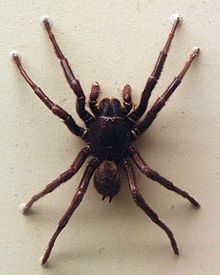Family Hexathelidae Rank Species | Order Araneae | |
 | ||
Similar Hadronyche, Hadronyche formidabilis, Hadronyche cerberea, Hadronyche versuta, Hadronyche modesta | ||
Toowoomba or darling downs funnel web hadronyche infensa
Hadronyche infensa, the Darling Downs funnel-web spider, is a venomous mygalomorph spider, one of a number of Australian funnel-web spiders found in Queensland and New South Wales.
Contents
- Toowoomba or darling downs funnel web hadronyche infensa
- Juvenile hadronyche infensa feeding
- Taxonomy
- Description
- Distribution and habitat
- Toxicity
- References
Juvenile hadronyche infensa feeding
Taxonomy
The Darling Downs funnel-web spider was described by Hickman in 1964 as Atrax infensus before being moved to the genus Hadronyche in 1988. The type specimen is a male spider that was collected in Toowoomba, Queensland, in 1963. Within the genus, it is a member of the infensa group, which contains several described and undescribed species in central New South Wales and southern Queensland.
Description
Like many funnel-web species, both sexes of the Darling Downs funnel-web have a shiny black carapace, dark brown to black legs, chelicerae and abdomen. The carapace is longer than it is wide. The abdomen of the male has a pale patch underneath.
Distribution and habitat
The Darling Downs funnel-web spider is found in eastern Australia, ranging from southeast Queensland to the northeastern portion of New South Wales.
Toxicity
The venom of male and female spiders is of equal toxicity. Two out of fourteen recorded cases of being bitten by a Darling Downs funnel-web spider have resulted in severe symptoms of poisoning. Bites from female spiders have also resulted in milder cases of envenomation. The poison can be successfully treated with the antivenom for the related Sydney funnel-web spider (Atrax robustus).
The venom of the Darling Downs funnel-web spider becomes more toxic in early summer after the spider has been fasting over the winter. Male spiders at this time are mobile and searching for a mate, meaning people are more at risk of encountering them and being bitten.
